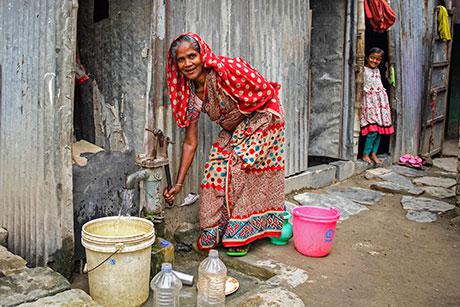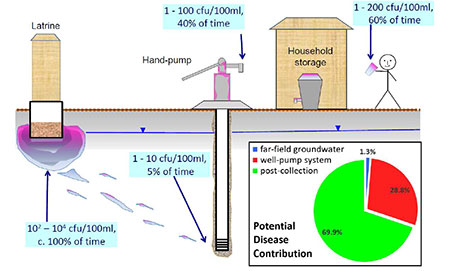Pit latrine minor contributor to diarrhoeal diseases in Bangladesh

Credit: GMB Akash/icddr,b
Pit latrines may not be a major threat to groundwater contamination as very few instances of such contamination have shown to occur in a new icddr,b study.
Consumed directly as drinking water, groundwater is contaminated more often due to poor hygiene at different stages of its acquisition – starting from the tube wells that draw the water and the water storage containers in households, suggests the study.
“In our study we found that groundwater pollution is rarely caused by pit latrines, which are essential to improve sanitation in resource poor settings,” says Professor John Clemens, MD, executive director at icddr,b and a co-author of the study published in the Water Research journal.
An earlier icddr,b study has already shown that groundwater contamination from pit latrines adjacent to tube wells in Bangladesh varies according to the water and soil conditions in different areas.
In order to ascertain how contamination might occur in different floodplains, the new study was conducted in four sites on the Ganges – Brahmaputra – Meghna delta. On rare occasions, a minor concentration of bacteria (1-10 cfu / 100ml) was seen to be transmitted from the pit latrines to groundwater sources.
In contrast, a rather dense bacterial concentration (1-100/200 cfu / 100 ml) was more frequently found inside the tube wells and in household water storage containers, which suggested that pollution may occur elsewhere, likely due to unhygienic practices.

Graphical extract from the paper. Credit: Authors
“Biofilms of bacteria form within old tube wells where faecal bacteria grow and remain to contaminate the water,” says Dr M Sirajul Islam, emeritus scientist at icddr,b and senior author of the study.
“We have also found algae and other elements growing inside wells and water storages, which further contaminate the water,” he adds.
The findings may suggest that latrine pollution of groundwater is a minor contributor to diarrhoeal diseases.
In order to avoid drinking water contamination, the study suggests a few interventions to maintain hygiene during tube well installation, routine cleaning of tube wells and improving water storages with better hygiene as well as increasing awareness, among other recommendations.
Read the publication here. The study was funded by DFID through the SHARE consortium.
This news story was first published by icddr,b.
